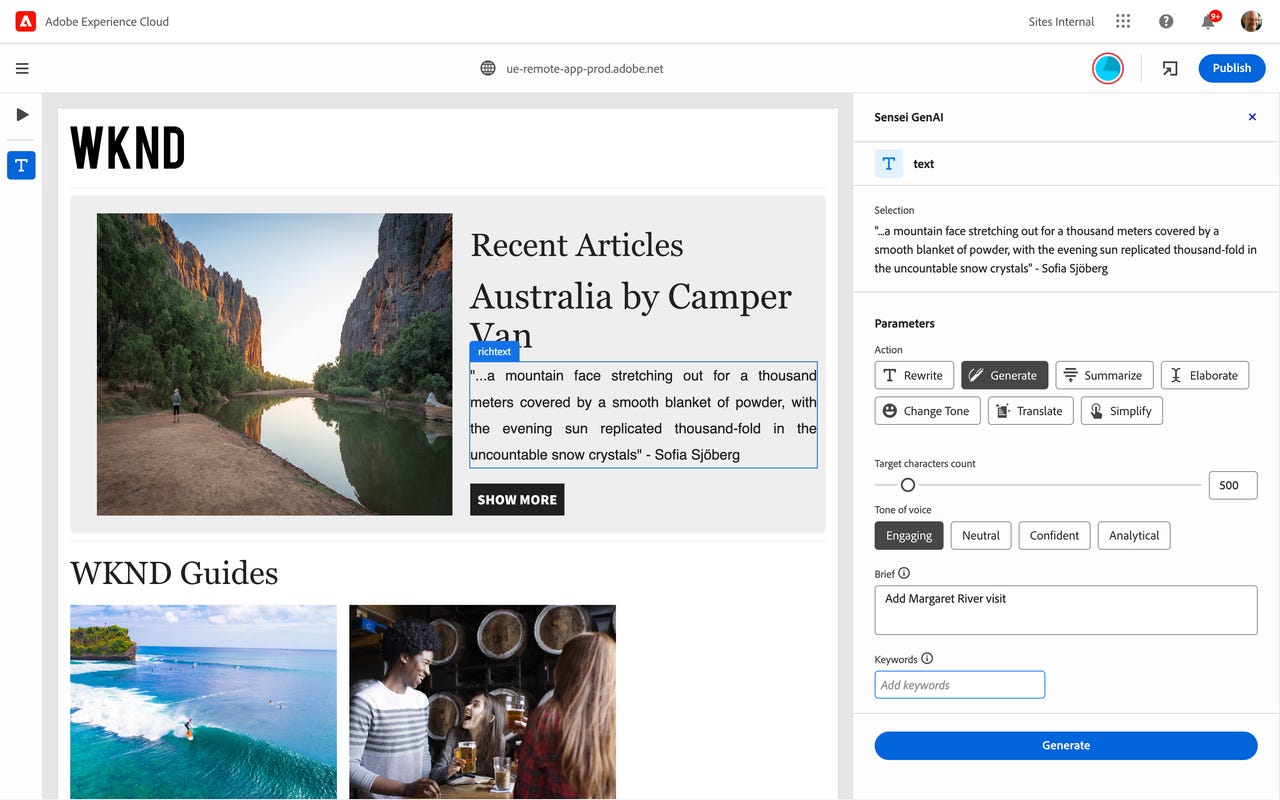Adobe’s customer experience offerings are getting a generative AI upgrade

Adobe’s new Sensei GenAI at work. Adobe
If you thought ChatGPT and the other generative AI tools are transformative to communication and understanding, wait until you see what happens when generative AI joins forces with marketing and sales teams.
We’re looking at an enormous increase in the ability for businesses to meet the unique needs of individual customers, as well as an enormous increase in the ability for businesses to target those customers with psychological and demographic precision. It gives a whole new meaning to “buyer beware.”
Also: How to use ChatGPT to write code
Rather than general-purpose AI tools that can respond to text prompts or generate images on demand, we’re starting to see more special-purpose tools using the same Large Language Model (LLM) approach we’ve been exploring in ChatGPT.
A first look at the future of generative AI-driven marketing became visible today at the Adobe Summit, which Adobe describes as the world’s largest digital experience conference.
Customer experience management and the buyer’s brain
Adobe is best known for its portfolio of tools for creative professionals. Product names like Adobe Photoshop, Premiere Pro, and Acrobat are familiar to nearly everyone. But Adobe is also a market leader in another business that might not be as familiar to everyone: customer experience management.
Customer experience (or CX) is one of the biggest buzzwords in the world of marketing-speak. But just because it’s one of those phrases only an AI could love doesn’t make it any less important. In fact, managing customer experience is critical to any business that wants to succeed in today’s market.
Also: The 5 best AI art generators
Put simply, “customer experience” is how your customers perceive their interactions with your company. “Perceive” is the key word. The better the perception of a customer experience, the more your company and brand create favorable associations in your customer’s psyche. The worse the perception of that experience, the more negative those associations and the less willing those customers will be to engage with you again.
When customers interact with your company, a lot goes on inside their heads. They start to build a map of your brand’s benefit to their lives. This isn’t just as they buy your stuff. There’s a pre-engagement psychological game going on as well: how much value they anticipate they’ll derive from your offerings. There’s experienced benefit, which is how much actual value or utility a customer gets. And then there’s the big one: retrospective benefit, which is the customer’s overall memory — positive or negative — of the experience.
Also: What is GPT-4? Here’s everything you need to know
Companies that maximize the perceived pre-benefit bring in more fresh opportunities. Companies that maximize the actual value benefit reduce support costs and create potential repeat customers. And companies that maximize the post-game engagement create champions, generate word of mouth, and turn customers into fans and enthusiasts.
That end-to-end experience, pre, purchase, and post, constitutes the customer experience. And, all of that brings us back to Adobe’s set of announcements.
Tapping the collective zeitgeist with the customer data platform
So how do brands turn customers into fans and enthusiasts in a predictable, repeatable, goal-directed manner? With data. Gobs and gobs and gobs of data. Petabytes of data.
According to Anjul Bhambhri, senior vice president, Adobe Experience Cloud platform engineering at Adobe, “In an unpredictable economic climate, where consumers now re-evaluate the products and services they buy each day, a brand’s key growth driver is the ability to show people you accurately understand their current needs.”
Also: How to get started using ChatGPT
Think about all the touch points with customers. There’s social media in all its forms, from Twitter and Pinterest, Facebook pages, groups, and everyone’s main feed. There’s email and chat. Phone support. Offline in-store visits. Offline event interactions. Mixed online/offline interactions like those that occur at trade shows. Every action on your web site or in your app. Every purchase. Every viewing of an ad, influencer video, or piece of editorial that mentions your offerings.
All of that information can and should be captured. The role of a customer data platform is to capture and then manage the flow of all that data so it’s not siloed. That’s a very, very big job.
But if there’s a surge in returns in the spring from products built in a cold factory during winter months, you need to be able to notice that behavior and make the intuitive leap to understanding what’s wrong, and then fix the problem. If a much-anticipated movie sequel is about to be released, perhaps you’ll want to stock up certain stores with goods that reflect the movie’s style or notify customers your analytics show you are fans of the movie’s genre.
This brings us to Adobe’s Real-Time Customer Data Platform (Real-Time CDP), which Adobe reports now delivers over 600 billion predictive insights annually based on real-time customer profiles.
Also: The best AI chatbots: ChatGPT and other interesting alternatives to try
Adobe today announced three new generative AI capabilities in its Real-Time CDP.
The first is rich segmentation. Adobe is using its new Adobe Sensei Generative AI Services capability to identify and define precision audience segments, allowing for personalized campaigns to be delivered at scale.
Next up is the Adobe Journey Optimizer, which games out customer experiences in real time, providing insights as they happen and providing “next-best offers and touch points for customers.” If you and your friend didn’t see the same offer from the same company at the same time, this may be why.
Then there are what the company calls Generative Playbooks. Customer journey guides have been around since product managers discovered they could get free coffee in the office. But what Adobe is offering is dynamically-created customer journeys, the ability to identify new use cases from raw data, and the ability to simulate customer behavior — all with the AI quality we’ve been seeing from GPT-style large language models. If you want to identify new opportunities and identify new markets, this tool will get you a far way along.
Also: How does ChatGPT work?
“Adobe Experience Cloud applications, from Adobe Real-Time CDP to Adobe Journey Optimizer and Customer Journey Analytics, work together to help brands drive the next phase of their digital transformation, which will be anchored in wide-scale personalization,” says Adobe’s Bhambhri.
Adobe is also pushing its game forward in healthcare, financial services, B2B, and retail. It has initiatives in these four areas:
Managing consumer data responsibly: Adobe’s Real-Time CDP prioritizes privacy and offers new Privacy & Security Shield and Healthcare Shield products for regulated industries and healthcare brands.
Enhancing B2B account-based marketing: Think of this as the customer journey, but on a company-to-company and team level.
Leveraging e-commerce for richer personalization: Adobe’s Real-Time CDP and Commerce integrations enhance e-commerce for brands by analyzing online behavior, targeting content, and personalizing offers.
Prospecting, Enriching and Activating with Partners: Adobe improves Real-Time CDP with partner enrichments, Amazon Ads, TikTok, LiveRamp integrations to solve cookieless prospecting challenges for brands.
This is how the customer experience and the customer data come together. Customer interactions generate more data. Real-time analytics changes the customer experience dynamically. Wash. Rinse. Repeat.
Adobe’s new image and text generative AI services
At Adobe Summit today, Adobe is banging the AI drum really, really hard. At the core of a second series of announcements are its Sensei GenAI Services. Given the current sensitive climate to cultural appropriation, it’s not entirely clear that “sensei” was Adobe’s best choice for branding its AI engine, but the capabilities available on offer seem impressive.
Also: I asked ChatGPT to write a WordPress plugin I needed. It did it in less than 5 minutes
One such tool is Firefly, trained on Adobe Stock images, along with public domain and copyright free images. The product, much like DALL-E 2 and Midjourney, can generate custom images. Interestingly, the company specifically says those images will be “safe for commercial use.” As with other generative tools — and the very capable Adobe Express — Firefly is designed to make it easier for marketers to create content without regard to artistic skill level.
On the text side of the generative AI equation (have you noticed the new “GenAI” buzzword?), Adobe’s introducing four new services based on large language models. These include:
Marketing copy generation: A tool for creating message variations, modifying tone of voice, and incorporate key words in the copy generated. As a guy who’s spent a large part of his life getting paid to write marketing copy, I’m not exactly sure what I think about this tool. It could help remove the drudgery. Or it could reduce billings.
Conversational experiences: This is a super-charged version of the chatbots used to power customer support widgets during off hours. Given my tech support experiences with ChatGPT, this could well reduce customer frustration and benefit the overall customer experience.
Caption generation: This is an enhancement to the company’s analytics offering (Customer Journey Analytics). The analytics tools help uncover opportunities or identify roadblocks. Where this tool comes into play is that it gives those opportunities and roadblocks relevant names to help marketers and managers visualize the overall impact of the data.
Also: The future of cloud computing, from hybrid to edge to AI-powered
“Adobe has a long history of unlocking Al as a co-pilot for marketers, and we have a vision for generative Al that covers the full lifecycle of customer experience management, with the enterprise-grade security and data governance that our customers expect,” said Amit Ahuja, senior vice president, Digital Experience Business, Adobe. “Business growth is driven by customer experiences, and generative Al is a transformative, foundational technology that will impact every aspect of how brands connect with their customers.”
So there you go. Adobe’s got a lot going on in its customer experience and AI offerings. What do you think? Will these improve actual customer experiences? Will they help your business manage growth and opportunities? Let us know in the comments below.
You can follow my day-to-day project updates on social media. Be sure to follow me on Twitter at @DavidGewirtz, on Facebook at Facebook.com/DavidGewirtz, on Instagram at Instagram.com/DavidGewirtz, and on YouTube at YouTube.com/DavidGewirtzTV.




